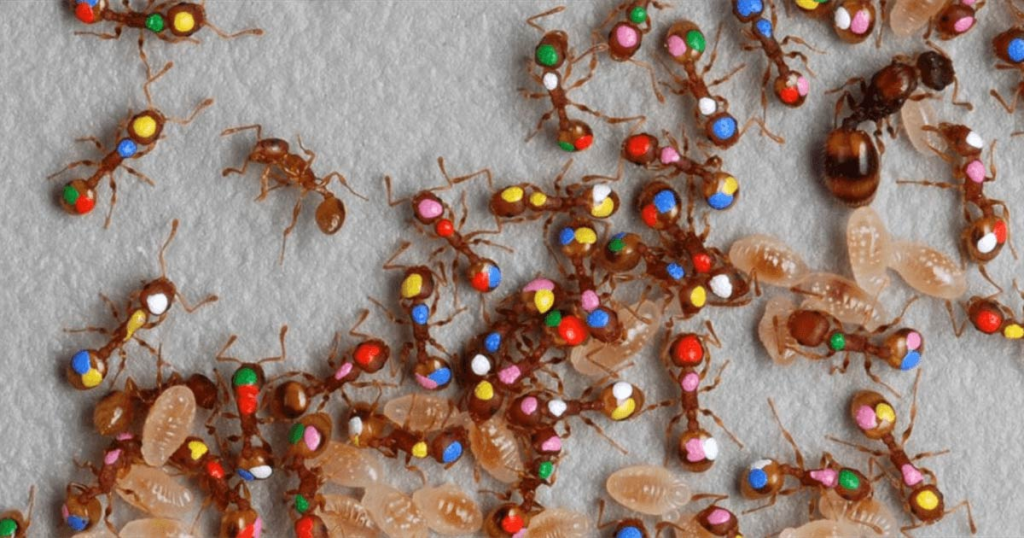Health
Do Ants Have Brains?
The central nervous system of an animal includes the brain. Even ants have brain. It is a collection of neurons that aid in the regulation, transmission, and reception of information to various body areas. The size and structure of brains vary greatly between animals. Many animals have ganglia in other locations that provide them extra control over limbs or other body parts, but these ganglia are usually still connect to the main brain. Corals, jellyfish, and oysters are a few of the species whose brains have been discover to be completely absent. These animals typically have smaller nerve clusters throughout their bodies that aid with sense-making and motor control.
Are Ants Intelligent?
Scientists debated whether to classify the collection of nerves in an insect’s head as a brain for a very long time. The fact that insects don’t do all of their thinking in one place was one particular difficulty. They have a network of ganglia situated all over their bodies in addition to the nerve cluster in their heads.
An example of a function that ganglia control is the movement of limbs. For a brief period of time, this is why a beheaded insect can still wiggle its legs or twitch. These groups of nerves run from the head through the thorax to the abdomen and are related to the brain.
Actual Brain Of Ants
The actual “brain” resembles a bigger ganglion and lacks a lot of the anatomy found in the brains of mammals. Similar to mammals, ants have brains that are house in their heads. These brains are then connect to the body’s numerous muscles, organs, and ganglia via a network of nerves.
Information travels in both directions, up to the brain from different body parts and down to the body from the brain, utilizing different chemical signals to transmit commands and receive feedback.
Because their jobs can be very diverse, ants’ brain sizes and structures vary greatly not only between species but also between various casts within the nest. The fact that smaller ants often have smaller brains is one of the primary differences. Smaller animals typically have proportionately smaller brains, therefore this is very usual in nature.
What Size Does The Ants Brain Have?
Ants are supposed to have a relatively large brain given their size, nonetheless. They are considered to be sociable creatures who use their brains to interpret complex interactions and communications, such as pheromones, touch, and visual cues. This is supposed to be the reason for their brain requirements.
The areas of the ant’s brain that process visual stimuli are typically quite small when compared to those of other insects. This is due to the fact that most ants have a mediocre vision. In winged men and females as well as predatory ants, this area of the brain is frequently larger since eyesight is a much more crucial factor in these species.
In comparison to other insects, ants have a comparatively big portion of the brain that processes sensory information from the antennae. This may be due to the fact that they rely more on the information coming from their antennas than from their eyes.
Hive brain
Around 250,000 neurons have been detected in a single ant brain. However, due to the highly collaborative character of ant society, many experts argue that the colony as a whole operates as one enormous brain made of numerous individuals.
It may be claimed that taken as a whole, the colony’s brain is comparable to the brain of a mammal. Each caste has its own specialized source of information that is essential to the survival of the colony since an individual ant’s brain can become highly specialized to perform a specific duty within a bigger colony.
How Does The Brain Function In Ants?
Ants
Ants employ their brains for a variety of purposes. Different types of information are processed by various brain regions. The majority of ants, for instance, have big, well-developed antennae lobes and significantly smaller vision lobes because their antennae serve as a more important sensory organ.
It has been demonstrated that memory ants have memories and that they can recall things like routes and places to collect food.
Vision
Individuals and ant species differ substantially in the utility of eyesight. The majority of ants have two compound eyes and up to three tiny simple eyes, known as ocelli, although some are completely blind, meaning they have no visual information to process.
Ants will have a variety of visual inputs to analyze depending on their activity, such as identifying landmarks, using polarized light to navigate, or locating food or predators.
Antenna Perception
For ants, antennae are a significantly more significant source of information than vision. Chemosensors that resemble hairs are spread out across the surface of the antennae. The sensors are programmed to detect specific substances. These substances could be compounds that signal the presence of food or even a danger.
Pheromones, which are chemical trails that ants leave behind, are used to direct one another to food sources or even back to the colony. In fact, it has been shown that colonies have their own distinctive odor, allowing ants to recognize whether an intruder is an enemy rather than a friend because they come from a different colony.
Antennae are used to sense through touch and can also gather data like temperature and humidity in addition to chemical detection.
Movement
Ant brains must process internal messages in addition to exterior information in order to move their bodies. Controlling their legs, wings, teeth, and other body processes like spiracles opening and closing will fall under this category.
Sound
In comparison to humans, ants place less importance on hearing. They frequently use pheromones or body language instead of sound to communicate.
However, ants can hear sounds because they can sense vibrations in their feet. Some species rub their legs against their exoskeleton to make a sound when they are in danger, another way they use sound to communicate.
Compared to pheromones, this sound travels farther, making it easier to summon assistance from a distance.
Zombie Ant Fungus That Tricks The Brain
The zombie ant fungus is one of the most intriguing and horrifying examples of brain manipulation by a secondary species.
This fungus has evolved to infect different species of ants, along with a number of other closely related fungi. When an ant becomes infected, the fungus releases chemical signals into its system that look just like chemical signals coming from the ant’s brain, effectively hacking the ant’s internal computer.
Once in control, the fungus scales a plant and uses its mandibles to grab hold of it, anchoring itself there. Following the ant’s total consumption, the fungus bursts from its body and spews spores that can infect fresh ants.
It’s been discovered, however, that the compounds the fungus produces are particular to a preferred host species and fail to have the desired effect when other ant species are infected.
A Stupid Queen
The queens of Indian jumping ants have a particularly intriguing skill, according to scientists.
These ants compete to see who will succeed the queen when she dies. When the final worker ant has triumphed in the games, her brain will reduce by 25% as her ovaries start to expand.
Even more intriguing, research has shown that if she loses her reign, she can regenerate the destroyed synapses.
Smart Ants
Human perceptions of intelligence are frequently heavily biased toward the traits we associate with intelligence. from the capacity for puzzle-solving to an expression of emotion. However, it’s possible that the subject of animal intelligence should instead take into account their demands.
Although ants may not be the most intelligent creatures in the world individually, their brains are so perfectly adapted to collaborate with one another and carry out specific tasks that they have truly conquered the world. It is thought that up to 20% of the animal biomass in the world may be made up of ants.
Whether or not it is possible to accept that ants are a sophisticated species, there is no denying that their design is nothing short of brilliant.
Does An Ant’s Brain Outweigh Its Body?
Picture of a Carpenter Ant on a Leaf
Ritesh Ghosh / Getty Images
To fit within an ant’s body, the brain needs to be smaller than the body. the connection between their head and body
The allometric brain-body size is less in ants than in vertebrates, according to research on brain allometry in ants conducted at the University of Zurich.
This suggests that ants have brains that are somewhat smaller than their physical proportions.
Do Ants Feel Emotions?
Individual ants may not have feelings, but a whole ant colony might. Ants have diverse neurological systems, and they lack the brain regions in humans that are in charge of experiencing complex emotions. As a result, they don’t display nuanced emotions.
However, ants use their antennae to use their sense of smell to detect and distinguish between pleasant and bad smells. Because of this, ants don’t hurt when you squash them.
Do Ants Have Intelligence?
Ants are not particularly intelligent on their own. Their intelligence is comparable to that of any other insect, but when we look at the colony as a whole, they have an incredibly high IQ.
Nevertheless, since they are capable of acting independently, ants are not all stupid. However, you can be sure that it will be more successful when the entire colony makes decisions.
Many people think that each individual ant is like a brain cell, while the colony represents the brain since an ant colony’s collective activity results in a highly sophisticated output. This analogy might be summarized as “more is better”.
Understanding The Functions And Brain Of Ants
The most intricate organ in an animal’s body and an essential component of the central nervous system is the brain (CNS).
It is in charge of starting bodily motions, managing actions, regulating the body, and interpreting chemical and electrical signals sent to and received from other body parts.
Although the majority of animals’ anatomy includes the brain, others don’t. However, they typically have nerve clusters all over their body that function like brains.
Animals’ brains vary widely in kind, size, and structure.
Other organs of insects function like little brains. In insects, a number of ganglia and nerve clusters carry out tasks similar to those of the brain.
The brain of an ant is found in its head, and it communicates with other organs and muscles by nerves. It is a network of ganglia that run the length of its body.
Generally speaking, all ants have a sizable brain. However, different ant species and casts have different brain sizes and structures.
How Do Ants Cooperate?
Some scientists contend that ant colonies operate as a single organism, or “superorganism,”. Because they are so highly developed and integrated. The ant is sociable. So colonies are the collective living arrangements that they use for foraging and working.
Organ systems make up human bodies. Our brain makes decisions, our heart pumps blood, and our stomach breaks down food. Each ant in the colony does not do every task. It just as each body part does not perform every single task. Ant workers construct and maintain the nest and gather food, while ant queens are in charge of reproduction. Moreover all the ants in an ant colony are related, much like all the cells in our body are. All of the workers are sisters, and the queen is the mother. Division of work is a biological principle that applies here.
Ants make choices thanks to cooperation. Each ant has its own path it takes when searching for food. If it locates food, it leaves a pheromone-filled chemical trail. The following ant detects the trail and follows it using the quickest route. The ants eventually identify the shortest path out of a thousand possible ones. With this method, the issue of the traveling salesman is resolved.




















